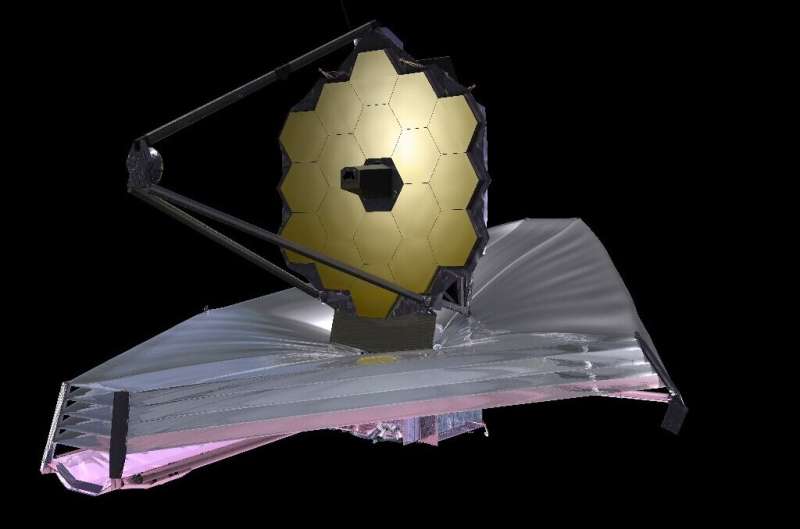Bernese researchers simulate defense of the Earth
Thursday, 30 June 2022 05:27 NASA's Double Asteroid Redirection Test (DART) mission is the world's first full-scale planetary defense test against potential asteroid impacts on Earth. Researchers of the University of Bern and the National Centre of Competence in Research (NCCR) PlanetS now show that instead of leaving behind a relatively small crater, the impact of the DART spacecraft on its target could leave the asteroid
NASA's Double Asteroid Redirection Test (DART) mission is the world's first full-scale planetary defense test against potential asteroid impacts on Earth. Researchers of the University of Bern and the National Centre of Competence in Research (NCCR) PlanetS now show that instead of leaving behind a relatively small crater, the impact of the DART spacecraft on its target could leave the asteroid Historic Mars mission completes all preset tasks
Thursday, 30 June 2022 05:27 Tianwen 1, China's historic Mars mission, has accomplished all its preset scientific tasks, according to the China National Space Administration.
The administration said on Wednesday that the Tianwen 1 mission orbiter has obtained medium-definition images of the entire planet, marking the completion of its scientific goals.
The craft has circled Mars 1,344 times to date and will cont
Tianwen 1, China's historic Mars mission, has accomplished all its preset scientific tasks, according to the China National Space Administration.
The administration said on Wednesday that the Tianwen 1 mission orbiter has obtained medium-definition images of the entire planet, marking the completion of its scientific goals.
The craft has circled Mars 1,344 times to date and will cont Successful high-speed flight experiments with new sounding rocket configuration
Thursday, 30 June 2022 05:27 Reusable launch systems are exposed to high dynamic and thermo-mechanical loads during their return to Earth. The German Aerospace Center has now successfully tested high temperature structures, advanced measurement techniques and design tools for the re-entry phase with the STORT (Schlusseltechnologien fur hochenergetische Ruckkehrfluge von Tragerstufen - key technologies for high-energy return
Reusable launch systems are exposed to high dynamic and thermo-mechanical loads during their return to Earth. The German Aerospace Center has now successfully tested high temperature structures, advanced measurement techniques and design tools for the re-entry phase with the STORT (Schlusseltechnologien fur hochenergetische Ruckkehrfluge von Tragerstufen - key technologies for high-energy return Rocket Lab's Lunar Photon completes 3rd orbit raising maneuver for CAPSTONE Moon mission
Thursday, 30 June 2022 05:27 Rocket Lab USA, Inc. (Nasdaq: RKLB) reports that its Lunar Photon spacecraft has successfully completed the third of seven planned orbit raising maneuvers, bringing the CAPSTONE spacecraft closer to the Moon.
Owned and operated by Advanced Space on behalf of NASA, the Cislunar Autonomous Positioning System Technology Operations and Navigation Experiment (CAPSTONE) CubeSat will be the first
Rocket Lab USA, Inc. (Nasdaq: RKLB) reports that its Lunar Photon spacecraft has successfully completed the third of seven planned orbit raising maneuvers, bringing the CAPSTONE spacecraft closer to the Moon.
Owned and operated by Advanced Space on behalf of NASA, the Cislunar Autonomous Positioning System Technology Operations and Navigation Experiment (CAPSTONE) CubeSat will be the first SES's C-band satellite launched onboard SpaceX Falcon 9
Thursday, 30 June 2022 05:27 SES has announced that the SES-22 satellite was successfully launched into space onboard a SpaceX Falcon 9 rocket from SpaceX's Space Launch Complex 40 at Cape Canaveral Space Force Station in Florida, United States, at 5:04 pm local time.
The first of SES's C-band satellites dedicated to freeing up the lower 300 MHz of C-band spectrum is built by Thales Alenia Space, and will operate in t
SES has announced that the SES-22 satellite was successfully launched into space onboard a SpaceX Falcon 9 rocket from SpaceX's Space Launch Complex 40 at Cape Canaveral Space Force Station in Florida, United States, at 5:04 pm local time.
The first of SES's C-band satellites dedicated to freeing up the lower 300 MHz of C-band spectrum is built by Thales Alenia Space, and will operate in t My Favorite Martian Image: 'Enchanted' Rocks at Jezero Crater
Thursday, 30 June 2022 05:27 Not even Obi-Wan Kenobi could convince Perseverance's Katie Stack Morgan that these are not the rocks she's looking for.
Ask any space explorer, and they'll have a favorite photograph or two from their mission. For Katie Stack Morgan, the deputy project scientist for NASA's Perseverance Mars rover, the first close-up image of layered rocks at the base of Jezero Crater's ancient river delta
Not even Obi-Wan Kenobi could convince Perseverance's Katie Stack Morgan that these are not the rocks she's looking for.
Ask any space explorer, and they'll have a favorite photograph or two from their mission. For Katie Stack Morgan, the deputy project scientist for NASA's Perseverance Mars rover, the first close-up image of layered rocks at the base of Jezero Crater's ancient river delta A sanitizer in the galactic centre region
Thursday, 30 June 2022 05:27 Many of us have probably already - literally - handled the chemical compound iso-propanol: it can used as an antiseptic, a solvent or a cleaning agent. But this substance is not only found on Earth: researchers led by Arnaud Belloche from the Max Planck Institute for Radio Astronomy in Bonn have now detected the molecule in interstellar space for the first time.
It was observed in a "deliv
Many of us have probably already - literally - handled the chemical compound iso-propanol: it can used as an antiseptic, a solvent or a cleaning agent. But this substance is not only found on Earth: researchers led by Arnaud Belloche from the Max Planck Institute for Radio Astronomy in Bonn have now detected the molecule in interstellar space for the first time.
It was observed in a "deliv NASA previews 'emotional' impact of James Webb images ahead of release
Thursday, 30 June 2022 05:27 The highly anticipated first photos from the $10 billion James Webb Space Telescope provided scientists with an emotional experience, NASA officials said Wednesday, two weeks before their public release.
Thomas Zurbuchen, the head of NASA's scientific programs, said the telescope, which was launched into space in December, and its images are shedding light on "a new worldview."
H
The highly anticipated first photos from the $10 billion James Webb Space Telescope provided scientists with an emotional experience, NASA officials said Wednesday, two weeks before their public release.
Thomas Zurbuchen, the head of NASA's scientific programs, said the telescope, which was launched into space in December, and its images are shedding light on "a new worldview."
H EGNOS technology for Africa - ESA signs deal with ASECNA
Thursday, 30 June 2022 05:27 European technology that allows satellite navigation signals to safely guide aircraft down for landing in the majority of Europe's airports will now be put to use across Africa and the Indian Ocean. ASECNA, the Agency for Air Navigation Safety in Africa and Madagascar, and ESA has signed an agreement to deploy a Satellite-based Augmentation System (SBAS) across a service region of more than 16.5
European technology that allows satellite navigation signals to safely guide aircraft down for landing in the majority of Europe's airports will now be put to use across Africa and the Indian Ocean. ASECNA, the Agency for Air Navigation Safety in Africa and Madagascar, and ESA has signed an agreement to deploy a Satellite-based Augmentation System (SBAS) across a service region of more than 16.5 Canadian students prepare their CubeSats for launch
Thursday, 30 June 2022 05:27 On June 29, 2022, Canadian students from Dalhousie University and the University of Victoria will be at Canadian Space Agency (CSA) headquarters to finalize the preparation of their CubeSats for launch. They are the first students from the Canadian CubeSat Project (CCP) to reach this important milestone, confirming their miniature satellites are qualified to be launched into space and deployed f
On June 29, 2022, Canadian students from Dalhousie University and the University of Victoria will be at Canadian Space Agency (CSA) headquarters to finalize the preparation of their CubeSats for launch. They are the first students from the Canadian CubeSat Project (CCP) to reach this important milestone, confirming their miniature satellites are qualified to be launched into space and deployed f NASA's stratospheric balloon mission gets telescope with giant mirror
Thursday, 30 June 2022 05:27 Telescopes designed to operate in space have to be constructed differently than those meant to operate on the ground. But what about telescopes that operate in between?
An upcoming NASA mission will use a balloon larger than a football field to send a telescope 130,000 feet (about 40,000 meters) above Antarctica. From that height, the telescope will study a phenomenon that chokes off star
Telescopes designed to operate in space have to be constructed differently than those meant to operate on the ground. But what about telescopes that operate in between?
An upcoming NASA mission will use a balloon larger than a football field to send a telescope 130,000 feet (about 40,000 meters) above Antarctica. From that height, the telescope will study a phenomenon that chokes off star Shenzhou XIII astronauts doing well after returning to Earth
Thursday, 30 June 2022 05:27 The three crew members of the Shenzhou XIII have recovered from the physical effects of their six-month mission and will return to routine training after medical assessment, according to the chief of the People's Liberation Army Astronaut Division.
Major General Jing Haipeng, commander of the division, told a news conference at the unit's headquarters in northwestern Beijing on Tuesday tha
The three crew members of the Shenzhou XIII have recovered from the physical effects of their six-month mission and will return to routine training after medical assessment, according to the chief of the People's Liberation Army Astronaut Division.
Major General Jing Haipeng, commander of the division, told a news conference at the unit's headquarters in northwestern Beijing on Tuesday tha NASA prepares to release first JWST science images
Thursday, 30 June 2022 00:32
With commissioning of the James Webb Space Telescope nearly complete, project officials and NASA leadership promise the telescope’s first images will stun scientists and the public alike.
The post NASA prepares to release first JWST science images appeared first on SpaceNews.
SpaceX launches SES-22 C-band replacement satellite
Wednesday, 29 June 2022 20:50
SpaceX launched the first television broadcast satellite under SES’s C-band clearing plan June 29 from Cape Canaveral in Florida.
The post SpaceX launches SES-22 C-band replacement satellite appeared first on SpaceNews.
Webb telescope: NASA to reveal deepest image ever taken of universe
Wednesday, 29 June 2022 20:09
NASA administrator Bill Nelson said Wednesday the agency will reveal the "deepest image of our universe that has ever been taken" on July 12, thanks to the newly operational James Webb Space Telescope.
"If you think about that, this is farther than humanity has ever looked before," Nelson said during a press briefing at the Space Telescope Science Institute in Baltimore, the operations center for the $10 billion observatory that was launched in December last year and is now orbiting the Sun a million miles (1.5 million kilometers) away from Earth.

